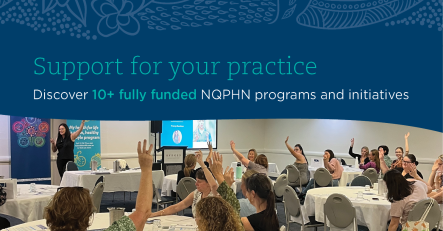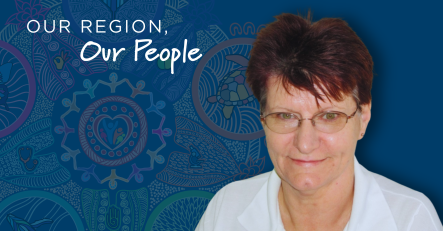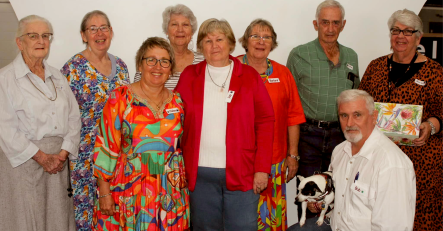 0 min read
0 min read
How can we help you today?
 Title: The Indigenous Healing Mandala
Title: The Indigenous Healing Mandala
The Indigenous Healing Mandala artwork explores Northern Queensland Primary Health Network’s (NQPHN’s) commitment to improving the health and wellbeing of Aboriginal and Torres Strait Islander peoples within our region.
It recognises the importance of an inclusive and culturally-appropriate approach for NQPHN to work with local communities in achieving its vision of helping all northern Queenslanders to live happier, healthier, longer lives.
The combination of Aboriginal and Torres Strait Islander components throughout the artwork represents NQPHN’s collaborative approach in strengthening its relationships with Aboriginal and Torres Strait Islander peoples and communities, and nurtures belief and purpose through healthy connections.
The basic circle shape of the mandala is the symbol of eternity, just as spirits are eternal. It also represents the need for people to take care of the body that carries them.
 At the centre of NQPHN’s Indigenous Healing Mandala artwork sits the heart, which encapsulates the family unit. Surrounding this family unit is primary health care (NQPHN) and other healthcare professionals in the community, who link and work together in unity to provide primary health support and education to achieve better living practices.
At the centre of NQPHN’s Indigenous Healing Mandala artwork sits the heart, which encapsulates the family unit. Surrounding this family unit is primary health care (NQPHN) and other healthcare professionals in the community, who link and work together in unity to provide primary health support and education to achieve better living practices.
The linking of hands also represents the evolution of relationships and reconciliation through respect and opportunities.
The five symbols (apple, microscope, healing hand, stethoscope, and ‘OK’ hand symbol) represent how primary health care links and flows into the community through the support of joint primary healthcare services:
- research and evidence (microscope)
- primary care and education (stethoscope)
- nutrition and healthy living (apple)
- healing and prevention (healing hand)
- mental health support and suicide prevention (‘OK’ hand).
The five animals in the circles represent the regions where they are commonly found, and the regions in which NQPHN commissions its services. They also represent unity and the strength local communities draw from them:
- manta ray (Torres Strait Islands)
- crocodile (Cape York Peninsula)
- butterfly (Cairns)
- turtle (Townsville)
- whale (Mackay).

 By drawing a line from each region in the above order, and then finishing with a line from Mackay straight back to the Torres Strait Islands, it creates the shape of a star, which indicates the potential of people who are living a healthy lifestyle.
By drawing a line from each region in the above order, and then finishing with a line from Mackay straight back to the Torres Strait Islands, it creates the shape of a star, which indicates the potential of people who are living a healthy lifestyle.
 The symbol of the meeting place surrounds the five regions, and represents where people gather to learn, educate, and practise healthy living.
The symbol of the meeting place surrounds the five regions, and represents where people gather to learn, educate, and practise healthy living.
The flowers on the outside of the mandala represent the beauty of the land throughout these five regions.
 Luke Mallie is an award-winning Indigenous artist, who has won the national NAIDOC Poster Award, and the Art Lovers Prize. Luke’s inspiration for his artwork is his family, his Aboriginal and Torres Strait Islander cultures, and his tropical surroundings. His work is also influenced by pop culture, animation, and modern design.
Luke Mallie is an award-winning Indigenous artist, who has won the national NAIDOC Poster Award, and the Art Lovers Prize. Luke’s inspiration for his artwork is his family, his Aboriginal and Torres Strait Islander cultures, and his tropical surroundings. His work is also influenced by pop culture, animation, and modern design.
“I feel that my artwork is my gift to help others appreciate the beauty of Australian Indigenous cultures through colourful art and designs,” he says.
While he was born and bred in Brisbane, Luke’s heritage is from North Queensland. His father is from Kubin Village on Moa Island in the Torres Strait Islands, where their spirit totems are the manta ray and sea eagle. His mother is from the Kuku Yalanji people in the Daintree/Mossman area, where their spirit totems are the saltwater crocodile and sea eagle.
Luke has drawn since he was a young child, and studied a B.A. of Visual Art (Fine Art) and a B.A. of Multimedia Studies. His artistic styles range from original paintings and graphic design to illustrations and murals.
To view more of Luke’s work, visit malliedesigns.com
Was this helpful?
Latest News
Read the latest news from NQPHN.







